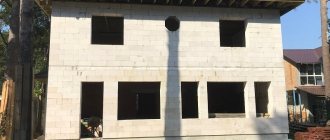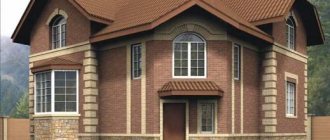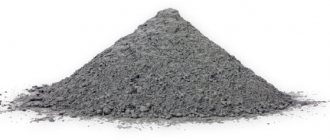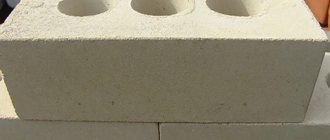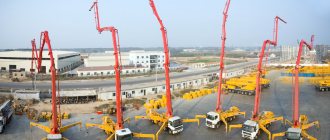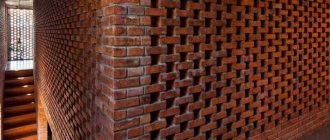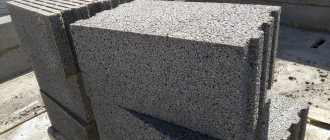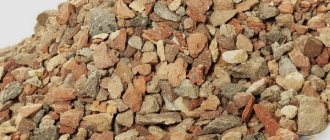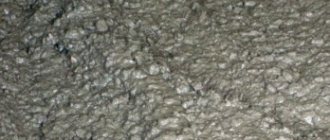The fact that brick is one of the most common and basic materials in construction is known even to people who have nothing to do with this area. The popularity of brick as a building material is determined by several factors.
Firstly, it is a strong and truly durable material.
Secondly, brick is considered environmentally friendly.
Thirdly, it can be used both for the direct construction of frames of buildings and structures, as well as for external decoration, solving aesthetic and design problems.
White sand-lime brick is one of the typical types of bricks in construction. White brick is most often considered as an example of the so-called “wall” bricks, that is, those that are used mainly for the construction of walls. However, this, of course, is not the only format for using this material. Below we will discuss in more detail what the features of such a brick are, how in practice it differs from the red ceramic brick that many are accustomed to, what is the standard size of sand-lime brick and what to consider when purchasing.
Specifics of sand-lime brick
The name in this case speaks for itself - the white brick is based on silicate, that is, a salt of silicic acid. In particular, the brick contains quartz sand, and in addition to it lime and concrete. Sometimes the composition contains additional impurities, but their content is usually insignificant.
The main component in this case is quartz sand, which accounts for about 90% of the volume and weight of sand-lime brick. Accordingly, all other components are of secondary importance.
The color of this brick is white precisely because of the quartz sand. At the same time, classic red brick has this shade because it is made from red ceramic clay.
The size of sand-lime brick is predetermined by the task of ensuring its best strength. During production, lime is mixed with water and quartz sand, poured into molds and heated strongly. In this case, the most important element is high pressure - only in this case will the setting reaction of lime and quartz occur, which guarantees the density of the brick. An autoclave is used with the ability to raise the heat to 200 degrees above zero and provide a pressure of up to 15 atmospheres. On average, one batch of sand-lime brick is produced in about a day, sometimes less.
In this sense, the size of a standard brick is designed in such a way that the mass sets and hardens as quickly as possible. Of course, in production it is mandatory to monitor compliance with the clear geometric shape of each brick - there are special standards for this.
It is curious that quartz bricks were first produced at the end of the 19th century (around 1880). Even then, in Germany, walls began to be built from such material for the first time. The technology quickly took root and, with some modifications and adjustments, exists to this day, actively improving and acquiring an increasing number of regulations and standards.
Hollow or solid?
An equally important parameter in addition to size is the presence or absence of sand-lime brick voids.
Hollow models have voids and irregularities. With their help, you can build walls of small thickness, while it is the voids that provide excellent thermal insulation. That is, a comfortable temperature is maintained inside the premises at any time of the year.
Solid bricks come in different colors (but white models remain the most popular). They have no voids, no cells. These are dense and wear-resistant products, but their weight is much more impressive.
Areas of application of sand-lime bricks
As mentioned above, this type of brick is equally successfully used for the construction of internal walls, as well as for external cladding.
Due to its characteristics and moderate cost, this material is perfect for the construction of large country houses, country cottages, as well as public and even industrial buildings.
You can often find quartz brick in foundations, load-bearing and frame walls, and fences.
However, there are some limitations due to the fact that quartz brick cannot withstand high temperatures and is excessively hygroscopic. In this regard, the use of white brick is impossible in the following specific cases:
- laying stoves or full-fledged fireplaces;
- masonry and cladding of any hydraulic structures.
How to choose the right brick
When choosing a material, pay attention to the following criteria:
- density - the higher, the more reliable the block;
- strength - using the indicator, they find out what load the product will withstand;
- porosity – if there are many pores, then the house will be warm;
- frost resistance - how many cycles of thawing and freezing the brick can withstand;
- fire resistance - will the material withstand high temperatures;
- moisture resistance - the higher the value, the less water the block will absorb;
- thermal conductivity - whether the block can retain heat inside the room.
Types of sand-lime bricks
Despite the existence of GOST standards during production, bricks may differ from each other in accordance with the subtype. Traditional classification is made based on the following criteria:
- According to the format of potential use - facing (smooth, with a cleaned, even surface) and structural (rough, needing plaster) brick.
- In terms of internal filling - hollow or porous (density less than 1500 kg per cubic meter) and solid (density 1500 kg per cubic meter or more) brick.
- The dimensions of the brick are 250 mm x 120 mm x 65 mm (single size), 250 mm x 120 mm x 88 mm (one and a half brick size) and 250 mm x 120 mm x 138 mm (double brick size).
- According to the markings, in accordance with the functions, there can be sand-lime bricks with varying degrees of frost resistance, water absorption, and strength. These criteria are indicated in numerical form and reflect the possibilities of practical application of this type of sand-lime brick.
Material properties
The raw materials for sand-lime brick are lime, quartz sand and water. The material is characterized by high performance properties, which are determined by GOST 379 95. One of these characteristics is the strength of silicate products. This parameter is considered decisive. It fully influences the overall reliability and durability of the building’s masonry and is designated by the index M (n), where n indicates the degree of strength of a particular modification of the lime brick product. For example, models with the M300 index are the most durable, withstanding 30 MPa in compression and 4 MPa in bending. This material is used for the construction of load-bearing walls of buildings, which are subsequently subjected to significant weight loads. However, it is not used for building foundations.
An equally important indicator of the performance characteristics of a brick is frost resistance, denoted by the symbol F (n), where n is the number of freeze-thaw cycles that the material can withstand without losing its basic performance properties. The frost resistance of products with a solid core corresponds to the F50 index, which is a good indicator and guarantees the preservation of the shape and working properties of the material for 50 years. Porosity and water absorption are also important characteristics of bricks. The porosity of glass-ceramic sand-lime brick is 1500 kg/m3, and its water absorption is in the range of 7.5-7.7%.
According to GOST, solid lime-sand brick is produced only in the form of one- and two-layer bricks. , two-seater models of this modification are not available. The sizes of the bricks are also standardized. The length of the individual parts is 25 cm, width - 12 cm, thickness - 6.5 cm. The half-models have dimensions of 250x120x88 mm. There are two types of sand-lime bricks, depending on their purpose. The first type includes cladding models used for cladding facades, and the second type - for laying walls and partitions.
It is important to ensure that it meets the following criteria:
Standard sizes
Like any other building material, white brick has certain criteria that it must meet in order to remain safe to use. Among other characteristics, the standard size of sand-lime brick has been established.
The standard specifically established by regulatory documents clearly defines the size of the brick. GOST prescribes, as already mentioned, that classic sand-lime brick is a rectangle 250 mm x 120 mm x 65 mm, 250 mm x 120 mm x 88 mm or 250 mm x 120 mm x 138 mm.
Thus, the length of the brick is always 250 mm, the width of the brick is always 120 mm, but the thickness of the brick can be different depending on its type - the size of a one-and-a-half brick and a double brick will, accordingly, be larger than a single one.
Please note that regulations prohibit any deviations from these parameters. That is, the appearance of some “non-standard”, “designer” or “author’s” sand-lime bricks is impossible. The dimensions of the brick should always be predictable so as not to make mistakes in calculations during construction.
By the way, this also applies to the volume of the brick and its weight. You can find out how much sand-lime brick weighs from the same GOST. According to him, there are seven weight options for bricks.
Why so much? This is due to what the dimensions of a standard brick are (primarily, what is the height of the brick), whether it is hollow or solid.
A single brick with standard parameters weighs 3.5 kg - this is considered a classic option. One and a half corpulent weighs 5 kg, and double corpulent weighs 7-8 kg. Additionally, weight is allocated for hollow single, hollow one-and-a-half and double bricks. A separate variety is thickened solid sand-lime brick, standard sizes.
You need to understand that when it comes to large-scale construction, counting bricks individually and then counting the total mass is not entirely convenient. For such purposes, the concept of the specific gravity of a cubic meter of brickwork was introduced. This means not just the weight of the bricks occupying such a volume, but additionally the weight of the glue, as well as the cement mortar.
This approach is very convenient, since there is no need to separately calculate each of the masonry elements - bricks, mortar, glue. You can immediately calculate the number of cubic meters and multiply by the appropriate value for a specific type of brick.
In the case of white silicate bricks, the specific gravity of a meter per cube is from 670 to 2100 kg. The final figure, as you might guess, depends on the size of the sand-lime brick, as well as on whether it is hollow or not.
Types of building bricks
Based on the material, bricks can be ceramic (clay, red) or silicate (white). By purpose - ordinary (construction) and finishing (facade). Ordinary is used for laying walls and requires subsequent finishing, so a notch can be applied to the side edges (of the spoons) so that the plaster holds better.
Types of bricks - ordinary and special
Depending on the method of molding, bricks can be solid or hollow (hollow). A solid one is formed from a homogeneous composition. They are used where mechanical strength is important - foundations, load-bearing walls.
The size of the brick and its quality characteristics are determined by GOST 530-2007
Hollow has a certain percentage of voids, due to which the weight of the structure is reduced and thermal conductivity characteristics are improved. But the presence of voids significantly reduces sound insulation performance - the voids act as resonators. So you need to use them wisely.
Markings for technical characteristics of sand-lime bricks
When describing sand-lime bricks, manufacturers are required to indicate a set of certain parameters.
The first of these is density. We are talking, accordingly, either about the density of a single brick, or about the density of a certain area of the finished product made from it.
Let us recall that the average density of white building brick according to GOST is 1500 kg per cubic meter. This applies to the standard size of brick, which is considered dense if it is solid, and porous if it contains internal voids. Most often, there is no separate marking for these two types of density; they can be distinguished from each other by their digital value. However, sometimes the density on the brick is indicated by the letter P.
The second parameter characterizing brick is strength. Here the classification is more harmonious and at the same time more detailed. In total, there are 6 classes for traditional sizes of white sand-lime brick. Marking for strength is M. The digital value of this parameter varies on average from 75 to 200. Strength reflects how capable the brick is of consistent compression and expansion without destroying its structure. For hollow bricks the typical minimum marking is M-25, for solid bricks the maximum marking is M-300. Almost always in damp rooms the strength of sand-lime brick decreases significantly.
Moisture absorption is also an independent labeling unit. The norm in construction is considered to be up to 6% moisture absorption. However, sand-lime brick almost always exceeds GOST standards for this value and reaches 12% moisture absorption.
The next characteristic is related to the resistance of the material to low temperatures - frost resistance. The letter reflecting this parameter is F. Frost resistance indicators reflect how many times a given material is capable of being frozen and defrosted without losing its basic properties.
Typically, white brick for interior walls does not require high frost resistance. The average F value for it will be 15. But bricks for facades, load-bearing walls, columns, fences, etc. require much greater frost resistance. Here, an F value of 100 or even more is considered average.
Some manufacturers make sand-lime bricks with increased frost resistance, which is achieved through special additives in the composition and sometimes slightly changes the size of the standard brick. However, it is strictly not recommended to abuse such approaches, since they do not comply with environmental standards and are not prescribed in GOST. For internal construction, such bricks are simply dangerous, but for external construction they can only be used in doses.
Another important marking characteristic is thermal conductivity. It is indicated for most building materials, since maintaining indoor temperature is always a primary concern.
For sand-lime bricks, thermal conductivity is predetermined by density. So, for hollow products it is lower - in the range between 0.55 and 0.8 Watts per meter Celsius (W/mC). In this case, for solid brick the value increases to 0.67-0.9 W/mS.
Tables of the main characteristics of sand-lime bricks
It is convenient to present the marking parameters and main technical characteristics of the material in a structured form. Below are the data for the size of standard white sand-lime brick.
Density in kg per cubic meter (for large structures)
solid brick – M150 (1600-1800), M200 (1800-2000)
hollow brick – M150 (1400-1500), M200 (1500-1600)
Strength in kg per square centimeter (for flat structures)
solid brick – M125-M200
hollow brick – M150-M200
Frost resistance (number of cycles while maintaining basic properties)
F35-F75 – identical value for all types and sizes of white sand-lime brick
Thermal conductivity in watts per meter degree Celsius
solid brick – 0.66-0.9
hollow brick – 0.57-0.8
Water absorption in percentage, %
solid brick – 7.8-10
hollow brick – 8-11
Sound insulation in decibels
51 – again the same value for all types of sand-lime bricks of standard sizes.
Specific gravity in kg
solid brick – 3.5-3.6 (for a standard size single brick) and 5 (for one and a half bricks)
hollow brick - about 3 (silicon brick standard sizes) and about 4 (one-and-a-half size)
In conclusion, it must be emphasized that the listed technical parameters apply only to sand-lime bricks. Although the size of an ordinary red brick is the same as the size of a white one, its markings and GOST standards are different.
Fireclay brick parameters
For the construction of stoves and fireplaces in the area of contact with fire, special fire-resistant bricks are used. In its production, a special type of clay is used - fireclay. That’s why such a brick is also called fireclay. The production process is the same as for building red bricks - molding, drying, firing in a kiln. But, due to the special properties of fireclay, the resulting building material can easily withstand prolonged contact with open fire. There are two brands of general-purpose refractory bricks used in everyday life: ShA and ShB. ShA can withstand temperatures up to 1690°C, ShB - up to 1650°C, all other parameters are identical. Therefore, their scope of application is the same - this is the molding of fireboxes for fireplaces and stoves.
Some types of fire bricks: sizes may vary, but they are all standardized
Encode the size of the refractory brick in the number that appears after the abbreviation:
- ШБ-5, ША 5 - 230*114*65 mm;
- ShB-6, ShA 6, ShA 14 - 230*114*40 mm (flying blade);
- ШБ-8, ША 8 - 250*125*65 mm;
- ШБ-9, ША 9 - 300*150-65 mm;
Most often they use ShA 8 or ShB 8. They are the same in length and thickness as the ceramic red brick from which the rest of the stove is made. There is also a wedge-shaped refractory brick - for forming firebox arches and smooth curves in the horizontal plane.
There are two types of wedge refractory bricks:
- end - for forming curves in the horizontal plane ША, ШБ 22 - 230 * 114 * 65/55 mm;
- ША, ШБ 23 - 230*114*65/45 mm;
- ША, ШБ 48 - 250*124*65/45 mm;
Types of wedge fireclay bricks: edge and end wedge
- ША, ШБ 44 - 230*114*65/55 mm;
These are not all the sizes and types of fireclay bricks. You will find more in GOST 8691-73.
Pros and cons of the material
Taking into account the parameters discussed in detail above, it is possible to determine the advantages and disadvantages of sand-lime brick as a material for full-fledged multi-tasking construction,
The main advantages of sand-lime brick:
- Possibility with the same guarantees of strength to be used for both internal and external construction, as well as for finishing.
- Impressive performance in terms of strength, durability, and density.
- Significant ability for noise reduction and thermal insulation, which is very important in the construction of buildings for any purpose.
- Environmental cleanliness (if we are not talking about special compounds outside GOST and distorted sizes of white bricks).
- Potential immunity of the material to mold, since the lime contained in the brick has antiseptic properties.
- Serious indicators in terms of frost resistance.
- Possibility of using various solutions during laying while maintaining good adhesion to the material. In particular, polymer adhesive is quite acceptable, and not just traditional cement-sand options.
- Classic rectangular shape, predictable size of sand-lime brick, when the length of the standard brick is always the same, as well as the width.
By the way, since the width of the brick is standard in all cases, you can easily calculate the required thickness of the masonry by varying the height of the structure by using standard, one-and-a-half or double silicate brick sizes.
Despite the large number of advantages, the material in question also has obvious disadvantages. The main disadvantages of sand-lime brick:
- The same geometric clarity can appear in a negative way if what is needed is not straight lines, but smoothness and fluidity of lines. For such cases, white bricks are not suitable.
- Inflated values of water absorption, affecting thermal insulation, strength and other characteristics, reducing them.
- Due to point 1, sand-lime brick cannot be used for swimming pools, basements, baths and saunas, as well as any other types of premises where high humidity is expected.
- For the same reason, the use of sand-lime brick requires particularly careful waterproofing and drainage work.
- The use of the material at elevated temperatures is unacceptable due to its poor heat resistance.
- Finally, sand-lime brick is considered a fairly heavy material, under which there must be a strong and reliable foundation. It is not always possible to use this brick on balconies, roofs, etc.
Product quality control: storage and transportation
All technical documentation about silicate is prescribed in GOST 379 2015, which also specifies control methods. The requirements specify the rules for storing and transporting the material.
Basic control methods
The following methods are distinguished:
- Quality standards for appearance, block dimensions - deviations from the norm are found using a square or ruler, less often a caliper is used. Please allow 1mm errors. Whether the mass is extinguished or not is determined visually.
- Product colors are checked against high quality samples. One option is pale, and the other is bright in color. Both types are normal. The material produced should not be very different, otherwise the products will not be accepted.
- Checking bending and compressive strength - check whether the product complies with GOST 24332 or 8462. In the second option, the bricks are placed under a press and create a large load.
- Frost resistance - samples for testing are first frozen and thawed. Specialized cameras are used for testing. When the cycles have been repeated the required number of times, a report is drawn up.
- Checking how the decorative coating adheres to the surface - glue a metal plate to the sample, and then try to tear it off.
- Thermal conductivity - creates a heat flow and directs it to the blocks. Record all measurements obtained and draw a conclusion.
- Water absorption - samples are first weighed dry and then immersed in water. Check the mass again.
Transportation of products and requirements for storage conditions
Loading and unloading of pallets with bricks must be done with cranes.
All goods are stored separately from each other by category:
- texture;
- color;
- size;
- technical indicators.
All warehouse premises are checked for compliance with GOST 379-95 and standards.
Freight transport is used to transport products. During the delivery of goods to their destination, the rules for packaging, fastening, loading, and unloading are followed. Blocks are transported on special pallets. Cannot be delivered in bulk or scattered. All products are pre-sealed with film.
What is better red brick or white?
This question is not idle and still remains one of the most common at the beginning of construction.
Each of the options has its own undoubted advantages, but in general it is worth noting that the choice should always be made taking into account the individual characteristics of the object, its intended purpose, the format of construction work and many other factors.
If we talk about statistics, ceramic brick still leads in terms of prevalence. Sand-lime brick takes an honorable second place. In addition, mixed masonry has recently become popular.
There are, however, cases when it is worth using only one specific type of brick.
So, for basements, saunas and baths, chimneys, fireplaces, bathroom areas, etc. Only red ceramic brick is suitable. It is also preferable in cases where it is necessary to pave a path or decorate a country house.
At the same time, the advantage of sand-lime brick is its price. This material is actually half the cost of red ceramic. It is white brick that is used for the construction of high-rise buildings or premises that require increased sound insulation. It is also ideal as an environmentally friendly material for the construction of partitions in a residential building between rooms.
The dimensions of the brick ultimately have more influence on the choice than its color and the material from which it is made. So, it has already been said that the double size of white sand-lime brick makes it heavier. At the same time, the double size of a red ordinary brick also retains a lot of weight behind it. In this sense, there is no difference between the two types of bricks.
However, in general, the prioritization between white and red types of brick is quite relative.
Weight of a pallet of solid bricks
When making such calculations, you need to know the mass of one specific material, the weight of the pallet itself and the number of products in the package, as mentioned above. As for the pallet, it looks like a wooden lattice, and its weight rarely exceeds 40 kilograms. Typically, manufacturers lay out bricks on a pallet in the form of a cube, which allows them to count materials at maximum speed.
It is known that one package contains 200-330 pieces of ceramic solid bricks, let’s calculate how much a pallet of bricks weighs, provided that the weight of such a product ranges from three to four kilograms:
- if there are 200 pieces of building materials in a pallet, and the mass of an individual copy is 3 kilograms, 200 × 3 = 600 kilograms; when using 330 pieces of bricks in a pallet 330×3 = 990 kilograms;
- if the mass of the product is 4 kilograms, for a package that contains 200 bricks 200×4 = 800 kilograms, for a package with 330 products 330×4 = 1320 kilograms.
To all the results you should add the weight of the pallet itself, 30-40 kg.
Features of masonry, video
So, if white silicate brick was nevertheless chosen as the main material for construction, it’s time to understand the specifics of masonry made from such bricks.
There is no special technology in this case. Moreover, since the dimensions of standard red brick and the dimensions of white sand-lime brick are completely the same, you can use universal brickwork when the joints do not overlap each other. This is the main and, in fact, the only important condition. Aerated blocks, shell rock and some other materials are traditionally laid in a similar manner.
Let's look at classic masonry in a little more detail.
- The first row of bricks is laid in accordance with the markings. Then it is mandatory to lay the corners (“steps”) - this is necessary in order to maintain the geometric shape.
- To ensure the most even masonry from one corner to another, it is necessary to stretch a marking thread, which will serve as a guide for each next row of bricks.
- The second and subsequent rows are placed in a dressing. The joints should not coincide, and the degree of adhesion of the bricks to each other may differ depending on the fastening composition used.
- A prerequisite is to check each subsequent row of masonry for compliance with the horizon line and the marking thread.
- It is also necessary to control the jointing for each row. This is what ultimately guarantees the aesthetic appeal and overall neatness of the masonry. This is especially important, of course, when cladding and decorative masonry of facades.
As for the features of cladding as an independent process, here you can use such techniques as perpendicular laying of bricks (half a stone thick), protrusions-columns at the corners of the masonry, installation with an edge, etc. In addition, an increased size of white brick can be used for external cladding.
In some cases, it is rational to use reinforcing mesh or wire masked inside the seams. This gives increased strength to the entire structure. In addition to this, for high walls you can use anchors (after about 5 rows).
Amount of material in one cube
Calculating a brick cube is somewhat more difficult. For example, consider a standard white single brick of size 250x120x65 mm. To calculate the cube of masonry, you must first find out the volume of one brick. It is 0.00195 m3. Next, the cubic meter must be divided by the resulting figure. Through calculations we find out that one cubic meter contains 512 silicate blocks.
| Type of brick | Length, mm | Width, mm | Height, mm |
| Single | 250 | 120 | 65 |
| One and a half | 250 | 120 | 88 |
| Double | 250 | 120 | 138 |
When choosing a white brick or block, it is important to consider its size. If you choose a material with inappropriate parameters, it will either not withstand the load placed on it.
Packing and packaging of sand-lime bricks
Factory packaging of white bricks is produced according to the same standard. This makes purchases more predictable and speeds up the process when, during construction, it is not possible to carry out calculations in the store for a long time. In addition, you can think in advance what the calculation of the material will be.
Number of bricks per square meter
If a calculation is made by area, then the costs of sand-lime bricks should be correlated with the size of the brick. If a wall is built from standard bricks one brick wide, then according to GOST you can expect the following consumption:
- A single white brick size is 204 pieces per meter.
- One and a half - 156 pieces per meter.
- Double - 104 pieces per meter.
Special calculations apply to thickened walls, when their width is 2.5 bricks. In this case, the flow rates are as follows:
- 255 pieces per meter - for single-size bricks
- 195 pieces per meter - for one and a half bricks
- 130 pieces per meter - for double bricks.
Number of bricks per cubic meter
It was already indicated above that when calculating volume, it is necessary to take into account both the standard size of sand-lime brick and its density. This requires special calculations.
For example, if we consider the usual size of a standard white solid sand-lime brick, then the calculations should be as follows:
- We find out the volume of one unit of material using the formula “length*width*height”
- divide one meter by the resulting volume
- the final number will be the value of the consumption of blocks per cubic meter during construction.
0,25*0,12*0,065=0,00195
1 / 0,00195 = 512,82
As you can see, in the case of “standard” bricks, the consumption per cubic meter will be a little more than 512 pieces, that is, when purchasing, it is better to rely on the value of 513 - for reinsurance. At the same time, you can take a risk by taking the number 512, since taking into account the mortar, the consumption of bricks will in any case be slightly reduced.
Number of sand-lime bricks in a construction pallet
Sometimes it is more convenient to count not by area or volume, but to rely on the tools that are used at a construction site. This applies to pallets for transporting bricks.
Here the quantity is not always the same, since the pallets themselves may be different. On average from 240 to 380 bricks. Specific values can be specified in accordance with the size and load of the pallet.
Number of sand-lime bricks in a factory pack
Here, too, a lot depends on the manufacturer. One package can contain from 480 to 560 bricks, and the exact value must be indicated on the pack itself along with the technical parameters of the brick (labeling).
A similar approach is used for all building materials. The number of pieces, density and size of ordinary red brick, as well as silicate brick, can also be determined by the packaging.
Buying unpacked bricks, in turn, is also not uncommon, which is why it is sometimes more convenient to use calculations by area and volume.
What is the weight of the blocks?
When purchasing, it is important to distinguish between volumetric weight and specific gravity. In the first case, this value depends on the presence of voids and porosity, i.e. characterizes the actual ratio of mass to volume, and in the second case the value of the maximum compacted material is used. This means that the latter is larger than the former, since there are factors that affect the density.
The average volumetric weight can vary from 1.23 t/m3 for porous blocks to 1.8 t/m3 for solid blocks. You need to know the weight of one cubic meter and one brick to calculate the total cost. The first value will allow you to choose a suitable and economical mode of transport, and the second - the weight of the structure and the distribution of load on the ground.
- The weight of one solid brick (250x120x65 mm) is 3.7 kg. Considering that there are from 200 to 380 pieces on a pallet, the weight for transportation will be from 740 to 1410 kg. One cubic meter contains 513 pieces, so the total weight will be 1.9 tons.
- The weight of half a lime-sand brick (250x120x88 mm) is 4.2 kg. One pallet holds 200-280 pieces, respectively 840-1400 kg. The total number of bricks per cubic meter is 379 pieces and the weight is 1,592 tons.
- The weight of the block (250x120x88 mm) ranges from 3 to 3.3 kg, depending on the quantity and size. One pallet holds 288-348 units, 0.865-1.148 tons.
- A block measuring 250x120x65 mm weighs 2.3-2.5 kg. There are 352-444 pieces on the pallet - 0.81-1.11 tons. A cubic meter contains 513 pieces weighing 1.283 tons.
The price depends on:
- density;
- dimensions;
- compound;
- manufacturer's brand.
The most expensive will be a full-bodied double, and the cheapest will be a hollow single. Choosing the right option depends on the requirements for the load-bearing capacity of the building, the selection of optimal loads and the construction budget.
The packaging weighs more than the value calculated or indicated in the characteristics, since the weight of the pallet of 30-40 kg is not taken into account. According to GOST 379-2015, density rounding to 10 kg/m3 is allowed, as well as deviations from dimensions: for ordinary blocks - ±2 mm, for front blocks - ±1 mm.
The actual weight of 1 sand-lime brick and the calculated weight may vary slightly. This does not have a significant effect on the overall load on the foundation. Not only cost is important, but also quality of workmanship and compliance with current norms and standards.
How to buy quality building materials?
It is important to ensure that it meets the following criteria
- it is made by a reputable manufacturer;
- the price of medium and high grade, since there is a high probability of purchasing blocks with lower parameters;
- Exact dimensions with an error not exceeding the requirements of GOST 379-2015;
- There are no defects, the edges are even and smooth;
- The material was stored in special warehouses in optimal climatic conditions, i.e. without temperature changes and high humidity.
If a structure is being erected without engineering calculations for private use, it is recommended to choose solid brick, as it is very strong, reliable and durable.
When purchasing hollow blocks, it should be taken into account that the total weight of the structure will be greater than the calculated one due to partial filling of the pores and holes with cement-sand mortar. When designing, a reserve of 10-15% of the bearing capacity should be provided.
White sand-lime brick is one of the typical types of bricks in construction. White brick is often considered an example of so-called "wall brick", i.e. bricks, which are mainly used for building walls. However, this, of course, is not the only application of this material. Below we will look in detail at the characteristics of these bricks, how they differ from ordinary red clay bricks, what is the standard size of lime-sand bricks and what you should pay attention to when purchasing them.
Age and shelf life of sand-lime bricks
Although the first sand-lime bricks were used in ancient times and have managed to survive to this day, modern material still has a limited period of use.
Durability is guaranteed only for those products that were manufactured in accordance with all standards and comply with the parameters established by GOST. In this case, the brick will serve for a maximum period and all its characteristics will really manifest themselves as stated in the marking table.
A little history
Brick is one of the oldest building materials. It can only compete with wood and stone, which exist in nature in ready-made form. Now, during excavations of settlements that are about 10-15 thousand years old, remains of walls built specifically from brick are found. True, we are talking about red clay brick, but white silicate brick appeared later.
In those days, the brick very slightly resembled its modern counterpart, but gradually the clay began to be fired in a kiln and in the sun, but the accuracy and correctness of the dimensions left much to be desired. This building material was especially popular in Greece, where entire buildings were erected from it or combined with marble. At that time, bricks with dimensions of 600*300*30 and 600*300*90 mm were common. The richest people could afford to order bricks even with a certain pattern, covered with glaze, and build a three-story house from this material.
But with the advent of the Middle Ages, many of the achievements of antiquity were forgotten, incl. and brick production technology. The masters remained only in Byzantium, but then, after its collapse, they began to develop the technology on the territory of European states. Gradually, brick comes to replace wood and natural stone; entire cities, churches, and the first industrial buildings are built from it. At that time, ceramic bricks already had clear dimensions. Thus, products with parameters of 150 * 70 * 35 mm were used, there was a special monastic type with a size of 280 * 130 * 70 mm, which was used for the construction of religious buildings. Larger bricks had a size of 280*130*80 mm and were named in honor of Martin Luther.
Brick factories at that time began to appear in many European countries, as well as in Russia. Each factory had its own approaches, its own rules, each produced bricks of a certain size, with its own mark. Attempts to somehow standardize the sizes of bricks and bring them to a single standard were made by Peter I, under whom it was believed that the most optimal products would be with dimensions of 280 * 140 * 70 mm. This was a real breakthrough in terms of quality: now all bricks were the same, the number of dishonest manufacturers decreased, and factories could not cheat and sell smaller products individually to save material.
Despite the widespread popularity of ceramic bricks, the rapid pace of construction required finding a simpler and faster method of production.
This is exactly how sand-lime brick appeared when people began to pay attention to pyramids built from limestone. They were durable, reliable, retained their original appearance, and then they decided to start using lime in the construction of buildings
At first they tried to make entire houses at once, then individual walls, but only at the end of the 19th century was it possible to make sand-lime brick for the first time. The production method has hardly changed today: then the brick was first pressed, then sent for autoclave processing. It was in Russia that the first factories for its production arose, and already in 1927 a standard for the size of bricks was introduced and then it regulated the dimensions at a level of 250 * 120 * 65 mm. By the way, these parameters formed the basis of modern GOST, which establishes the dimensions of bricks.
Since then, sand-lime brick has become one of the most popular building materials. It owes such wide distribution to its main advantages: low price, ease of production and cost-effectiveness, since walls made of sand-lime brick can be thinner than walls made of ceramic, but at the same time not inferior to them in terms of frost resistance, sound insulation and other indicators. In addition, sand-lime brick has a pleasant appearance; it can be painted in bulk and given any shade that will last.
Dimensions of sand-lime bricks in the Russian Federation
Uniform international standards only generally regulate the production of bricks; specific dimensions and models are established by each country independently. At the interstate level, there is a size chart for factory-produced brick briquettes; everything else, including packaging, packing and additional modifications (ultra-strong, extra-large size) is left to the regulations within the country.
In Russia, for example, the existence of one-and-a-half silicate bricks is unique. At the same time, its specific size remains very conditional, since it is not confirmed by clear mathematical calculations. Only the fact that another 0.5 is added to the standard width is taken into account. The same applies to the size of the red worker standard brick.
As for permissible deviations from the adopted GOST, they are also spelled out quite clearly. It is considered normal if an individual brick is 3-4 mm longer or shorter than the standard. For width, the permissible deviation range is limited to 2 mm.
Sand-lime brick has remained a popular building material for centuries and, apparently, is not going to lose its position. If in the near future manufacturers manage to solve the problem of its resistance to moisture and high temperature, white brick can completely take over the market and begin to displace its ceramic counterpart. The latter will remain as a decorative alternative due to color, but this aspect can also find its solution if white sand-lime bricks begin to be painted in different shades at the creation stage.
Special abilities
White sand-lime brick consists of quartz sand, concrete with various additives and lime.
White lime brick consists of quartz sand, concrete with various additives and lime. The percentage of sand-lime brick can be described as follows:
- 10-15% is lime;
- 80-90% is quartz sand and water.
The lime itself for sand-lime brick hardens slowly, so in order for the quartz to react with the material, high pressure and a higher temperature of the aqueous environment are necessary. The product is produced by synthesis in an autoclave. The prepared mass is subjected to dry pressing to give the component the required shape. The blocks are cured under the influence of steam and high pressure. Good quality lime-sand brick should have the correct geometric shape, and there should be no chips or other defects on its surface. The average weight of this product is about 4 kg.
In other words, if you want to know what this product is made of, it can be said that it is a calcareous silica material that is obtained by heat treatment in an autoclave. The first wall material made of lime-sand bricks was produced in October 1880. Initially, the production of sand-lime bricks was carried out only in Germany.
Important: The number of bricks in 1 m2 of masonry depends on its size and wall thickness and is: for single elements - 51 bricks. The number of bricks per m2 of masonry depends on its size and wall thickness and is: for single elements - 51 bricks. The number of bricks per 1 m2 of masonry depends on the size and thickness of the wall: in single elements it is 51 bricks (with a seam), in half elements it is 39 bricks, provided that the masonry is half a stone. Before laying a brick wall, you need to purchase 102 individual stones or 78 half bricks.
Sand-lime bricks, although they have the same composition, come in different sizes. They come in different sizes:
The age of the brick, is it time for it to retire?
Of the large assortment of building materials, only wood or stones compete with briquettes. The first records of the use of briquettes can be found in many ancient writings in Asia. Archaeologists also found briquettes during excavations in ancient Mesopotamia and China. Egyptian, Greek, Roman and Byzantine builders made extensive use of this material. So, according to the most minimal estimates, its age exceeds 10 thousand years.
The first attempts to establish a standard briquette size trace archaeologists back to ancient times. In Russia, this step was taken by the last Tsar of All Rus' and the first All-Russian Emperor. With him, the briquette, the dimensions of which were 280 * 140 * 70 mm, became the most relevant. At that time, the process was controlled by special measurements that each master had. This managed to achieve even minimal unification.
Some brick walls are thousands of years old!
When producing briquettes, a mark was affixed as evidence of full compliance with established standards. This policy caused a storm of criticism from craftsmen, because the latter sought retail sales, trying to reduce the established sizes to save materials.
Trends in installing the specified sizes of briquettes were traced until the beginning of the 20th century not only in the CIS countries, but also in all European countries. Manufacturers sought to follow established standards, because contradictions not only complicated installation with minimum dimensions, but also produced excess weight, which negatively affected the stability of buildings. At the same time, European countries began to use briquettes of different sizes, which gave the designs a certain charm and originality. This may explain the diverse range of materials presented below.
Thickened hollow brick for building a house
Despite the emergence of new opportunities on the market, brick does not give up its leadership position. But technological developments lead to improvements in traditional solutions. Today, hollow bricks are actively used in construction, which has many advantages over their solid counterparts. Thickened walls made of effective material are lighter, and the construction of a house is more economical.
Less raw materials are consumed in production, the quantity of which affects the cost of production. Reducing the weight of the bars due to the formation of voids is another important factor. Due to the lightness of the products, the cost of foundation equipment is significantly reduced. When building a house from hollow bricks, the costs of installing thicker walls are reduced without compromising the performance of the building.
Types of bricks popular in modern housing construction
White silicate, red ceramic and hyper-pressed bricks are common on construction sites All materials are available in solid versions and with holes. In critical areas of construction, it is more advisable to use solid bricks. It significantly increases the strength of load-bearing structures.
| White sand-lime brick | Red ceramic brick | Hyperpressed brick |
Ceramic products are characterized by an optimal balance of performance qualities, which is why they are especially popular. Solid red brick has a density of 1600-1800 kg/m3 and thermal conductivity of up to 0.5 W/(m•K). The parameters of hollow analogues reach 1100-1500 kg/m3 and 0.22-0.26 W/(m•K), respectively. Thermal conductivity is improved by 10-15% by adding perlite or slag to the masonry mortar.
Production of hollow thickened ceramic bricks
The raw material for the production of building ceramics is clay with a moisture content of 10-15%. The technology for manufacturing hollow bars is complicated by the need to use specific equipment. To form holes, cores are used, which are equipped with a hydraulic press. Bricks are produced with voids of various configurations, occupying from 15% according to GOST requirements, but more often - up to 30-40% of the volume.
Range of hollow bricks for construction needs:
- Red ceramic. A traditional building material made from natural clay. To improve technical characteristics in the manufacture of hollow bricks, additives are used that impart certain properties. The classic material forms a durable surface, looks impressive in masonry and serves as reliable protection for rooms from heat loss;
- Thermally efficient. Thickened ceramic bricks with a complex system of voids are designed for laying in one layer. The material with enhanced insulating characteristics is lightweight and economical. Thickened hollow walls create minimal load on the base, ensuring the preservation of a microclimate inside the house independent of external conditions;
- Porous. The building material serves as effective insulation from noise and heat loss due to its structural features. The porous surface and holes can significantly reduce the weight of products. Porous brick is often used not for building walls, but for cladding. Facade finishing looks great and reduces noise levels in the premises;
- Foam diatomite. The material with improved performance properties is intended for the construction of heating structures. Foam diatomite brick is resistant to extreme temperatures. Use for the construction of house walls is allowed, but turns out to be economically unprofitable due to the increase in cost;
- Cement-sand. The products are produced without the use of traditional clay. This is a budget building material, the production of which is cheaper than the production of ceramic and silicate analogues. The composition includes special components to enhance strength properties. Hollow bars on a cement-sand base are economical, but in many ways inferior to ceramics.
Ordinary hollow silicate brick thickened M-150 (SUR-150/35)
Cash and non-cash payments, including working with credit money. If you pay in cash, you can pay for everything at the office or upon delivery. By bank transfer - 100% prepayment. The manager will help you make a choice and suggest the best solution for a specific task.
Delivery terms
Delivery is carried out within the Republic of Belarus, the cost is calculated individually depending on the weight of the cargo and distance. Delivery by freight transport from 2 to 25 tons, both with and without manipulators - at a time convenient for the client. Unfortunately, we do not deliver building materials whose ordered quantity is less than the established minimum.
The price per conventional piece may vary depending on the quantity of bricks ordered. The stated price is valid for orders of 16 pallets or more. 1000 conventional bricks are 738 natural (physical) pieces, the conversion factor is 1.35. To avoid confusion with units of measurement, we recommend calculating the required material in m3.
Sand-lime brick is shipped on wooden pallets PKP-78ts1 with a deposit value of 10 rubles. 50 kopecks for 1 piece When the pallets are returned within the agreed time frame, the deposit cost of the packaging is returned to the buyer. The maximum load for one machine is 18 pallets.

